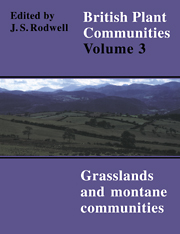Book contents
- Frontmatter
- Contents
- List of Figures
- Preface and Acknowledgements
- Preamble
- Mesotrophic Grasslands
- Community Descriptions
- Calcicolous Grasslands
- Community Descriptions
- Calcifugous Grasslands and Montane Communities
- Community Descriptions
- Index of Synonyms to Grasslands and Montane Communities
- Index of Species in Grasslands and Montane Communities
- Bibliography
MG12 - Festuca Arundinacea Grassland Potentillo-Festucetum Arundinaceae Nordhagen 1940
Published online by Cambridge University Press: 04 July 2020
- Frontmatter
- Contents
- List of Figures
- Preface and Acknowledgements
- Preamble
- Mesotrophic Grasslands
- Community Descriptions
- Calcicolous Grasslands
- Community Descriptions
- Calcifugous Grasslands and Montane Communities
- Community Descriptions
- Index of Synonyms to Grasslands and Montane Communities
- Index of Species in Grasslands and Montane Communities
- Bibliography
Summary
Synonymy
Lolium perenne-Matricaria suaveolens Ass. R.Tx. 1937 p.p.; Festuca arundinacea-Dactylis glomerata Ass. R.Tx. 1950; Festuceto-Dactyletum Oberdorfer 1957; Agrostis stolonifera-Festuca arundinacea nodum Adam 1976; includes Lolio-Agrostetum stoloniferae festucetosum arundinaceae Page 1980.
Constant species
Agrostis stolonifera, Festuca arundinacea, F. rubra.
Physiognomy
The Potentillo-Festucetum arundinaceae is a coarse grassland usually dominated by large tussocks of F. arundinacea with often abundant F. rubra and A. stolonifera and generally smaller amounts of Holcus lanatus. Apart from Elymus repens and Poa pratensis, which are occasional throughout, other grasses are rare. Saltmarsh stands in both sub-communities frequently have Carex distans, C. otrubae and Juncus gerardi.
Potentilla anserina and Trifolium repens are the most frequent and abundant dicotyledons with occasional Cirsium arvense, Vicia cracca, Lotus corniculatus, Trifolium pratense and Plantago lanceolata.
Bryophytes are rather infrequent, although Eurhynchium praelongum is sometimes abundant.
Sub-communities
Lolium perenne-Holcus lanatus sub-community: Agrostis stolonifera-Festuca arundinacea nodum Adam 1976 p.p.; Potentillo-Festucetum arundinaceae Nordhagen 1940 sensu Page 1980 and Lolio-Agrostetum stoloniferae festucetosum arundinacaea Page 1980. In this subcommunity H. lanatus mi&Iqv L. perenne are abundant among the F. arundinacea, A. stolonifera and F. rubra and sometimes share dominance. Anthoxanthum odoratum and Arrhenatherum elatius occur occasionally and each may be prominent in particular stands. Ranunculus acris, Lotus corniculatus, Trifolium pratense, Plantagolanceolata and Cerastium fontanum are preferential here but halophytes are poorly represented, although saltmarsh stands frequently have some Carex distans, C. otrubae and Juncus gerardi.
Oenanthe lachenalii sub-community: Festuceto-Caricetum distantis Duvigneaud 1967; Potentillo-Festucetum arundinaceae ranunculetosum acer Krisch 1974; Agrostis stolonifera-Festuca arundinacea nodum Adam 1976 p.p. Although H. lanatus and a number of species characteristic of inland mesotrophic grasslands are represented here, this sub-community is strongly distinguished by the frequency of salt-marsh species such as O. lachenalii, J. gerardi, Glaux maritima, Juncus maritimus and Triglochin maritimus. Sonchus arvensis, Odontites verna, Atriplex prostrata, Leontodon autumnalis and Hypochoeris radicata are also preferential and there are occasional records for Phragmites australis, Eleocharis uniglumis and Triglochin palustris.
Habitat
The community is characteristic of moist but usually free-draining soils in coastal sites which receive frequent inundation by brackish water, occasional tidal inundation or small amounts of salt-spray. It occurs along the banks of tidal rivers, on the upper salt-marsh and occasionally on slumping clay sea cliffs. It is generally ungrazed.
- Type
- Chapter
- Information
- British Plant Communities , pp. 99 - 102Publisher: Cambridge University PressPrint publication year: 1992



